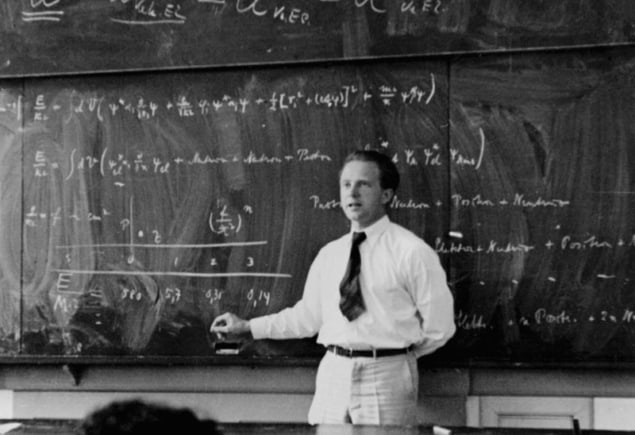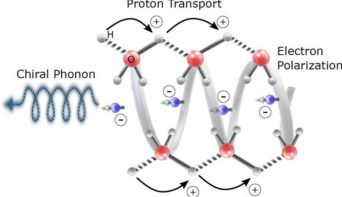
A group of physicists in Spain has shown how to make a quantum measurement that overcomes a limit related to Werner Heisenberg’s uncertainty principle. The researchers confirmed a theoretical prediction of how to beat the Heisenberg limit by using interacting photons to measure atomic spin, and they say that their approach could lead to more sensitive searches for the ripples in space–time known as gravitational waves and perhaps also to improved brain imaging.
The standard limit on the precision with which a quantum measurement can be carried out is due to the statistical error associated with counting discrete particles rather than continuous quantities. So, for example, when measuring the phase difference between the waves sent down two arms of an interferometer, the error in this quantity will scale with the square root of the total number of photons measured, N. Since the signal scales with N, the signal-to-noise ratio also scales in the same way. Or, put another way, the sensitivity of the measurement, which is the minimum signal that can be measured with a given level of noise, will scale with 1/N1/2.
It is possible to improve on this scaling, however, by entangling the photons, because this correlates what would otherwise be independent sources of noise from the individual particles. Such entanglement allows measurements to approach the so-called Heisenberg limit, which means that sensitivity scales with 1/N. Until recently it was thought that this scaling represented an absolute limit on the sensitivity of quantum measurements.
Caught in a trap
However, in 2007 a group led by Carlton Caves at the University of New Mexico in the US predicted that the Heisenberg limit could be beaten by introducing nonlinear interactions between the measuring particles. That prediction has now been shown to be true, thanks to an experiment carried out by Morgan Mitchell and colleagues at the Institute of Photonic Sciences at Barcelona. Mitchell’s group fired laser pulses into a sample of ultracold rubidium atoms held in an optical trap and measured how the atoms’ spin angular momentum caused the polarization axis of the photons to rotate.
In a linear measurement, each photon would interact separately with the atoms, resulting in a relatively weak signal. But what the researchers did was to carry out nonlinear measurements, ramping up the intensity of the laser pulses enough so that each photon, as well as registering the magnetic state of an atom also altered the electronic structure of that atom. This in turn left its mark on the polarization of the next photon, so amplifying the signal. “We have a signal that is not dependent just on the thing we are aiming at, but also on what we send in,” explains team member Mario Napolitano.
According to Napolitano, it wasn’t clear that a signal could in practice be amplified in this way because it was reckoned that the nonlinearity would increase the noise as well as the signal. But his team was able to tailor the nonlinearity accordingly, by concentrating the interaction between atoms and photons to a very tiny region of space and by very precisely tuning the frequency of the laser so that it was very well matched to the atoms’ electronic structure. Then by measuring the rotation in the photons’ polarization using an interferometer, measuring the noise and measuring the number of photons, then repeating this process for different photon numbers, the researchers were able to show that the sensitivity scales with photon number better than the scaling of the Heisenberg limit. In fact, they achieved a sensitivity that scaled with 1/N3/2.
Clocks and brains could benefit
Napolitano is keen to point out that this result does not imply that the Heisenberg uncertainty principle is wrong, but rather it shows that we do not properly understand how to scale that principle up to multiple-particle systems. He also believes that the work could ultimately have significant practical applications, such as improving atomic clocks, given that such devices rely on interferometers. What’s more, several research groups are investigating the possibility of measuring electrical changes in the brain by using light to probe the magnetic properties of atoms placed close to the brain, and the lastest work could enhance this technique.
Jonathan Dowling, a theoretical physicist at Louisiana State University in the US, says that the latest work could also help in the search for gravitational waves. Researchers hope to register gravitational waves’ distortion of space time by measuring the difference in path length experienced by laser beams travelling in the two orthogonal pipes of an interferometer. Dowling says that if the American LIGO detector could operate with a sensitivity that scales as 1/N3/2 rather than as 1/N1/2 then either its sensitivity could be greatly increased or its laser power enormously reduced, which would avoid potential heating and deformation of the facilities’ optics. “This opens up a whole new ball game in nonlinear interferometry,” he adds.
However, Barry Sanders, a quantum physicist at the University of Calgary in Canada, urges caution. “The experiment demonstrates that the Heisenberg limit can be beaten in the real world,” he says. “But practical applications are not likely in the near future because of the technical challenges that need to be overcome, especially noise. We are still exploring the basic physics of using quantum resources for precise measurements.”
The research is published in Nature.



